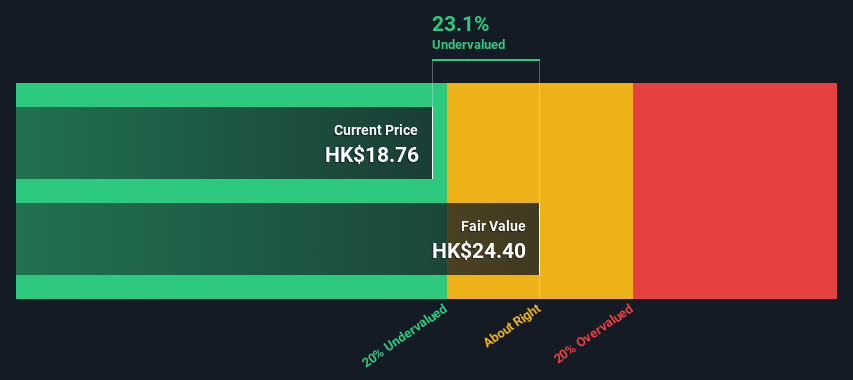- Hong Kong
- /
- Semiconductors
- /
- SEHK:1347
An Intrinsic Calculation For Hua Hong Semiconductor Limited (HKG:1347) Suggests It's 23% Undervalued

Key Insights
- Hua Hong Semiconductor's estimated fair value is HK$24.40 based on 2 Stage Free Cash Flow to Equity
- Current share price of HK$18.76 suggests Hua Hong Semiconductor is potentially 23% undervalued
- Analyst price target for 1347 is US$19.94 which is 18% below our fair value estimate
Today we will run through one way of estimating the intrinsic value of Hua Hong Semiconductor Limited (HKG:1347) by taking the expected future cash flows and discounting them to their present value. We will use the Discounted Cash Flow (DCF) model on this occasion. It may sound complicated, but actually it is quite simple!
We would caution that there are many ways of valuing a company and, like the DCF, each technique has advantages and disadvantages in certain scenarios. If you still have some burning questions about this type of valuation, take a look at the Simply Wall St analysis model.
See our latest analysis for Hua Hong Semiconductor
Is Hua Hong Semiconductor Fairly Valued?
We use what is known as a 2-stage model, which simply means we have two different periods of growth rates for the company's cash flows. Generally the first stage is higher growth, and the second stage is a lower growth phase. To start off with, we need to estimate the next ten years of cash flows. Where possible we use analyst estimates, but when these aren't available we extrapolate the previous free cash flow (FCF) from the last estimate or reported value. We assume companies with shrinking free cash flow will slow their rate of shrinkage, and that companies with growing free cash flow will see their growth rate slow, over this period. We do this to reflect that growth tends to slow more in the early years than it does in later years.
A DCF is all about the idea that a dollar in the future is less valuable than a dollar today, so we discount the value of these future cash flows to their estimated value in today's dollars:
10-year free cash flow (FCF) estimate
| 2024 | 2025 | 2026 | 2027 | 2028 | 2029 | 2030 | 2031 | 2032 | 2033 | |
| Levered FCF ($, Millions) | -US$754.4m | -US$111.3m | -US$554.1m | US$344.0m | US$524.0m | US$666.8m | US$797.9m | US$912.4m | US$1.01b | US$1.09b |
| Growth Rate Estimate Source | Analyst x7 | Analyst x6 | Analyst x2 | Analyst x1 | Analyst x1 | Est @ 27.25% | Est @ 19.66% | Est @ 14.35% | Est @ 10.64% | Est @ 8.04% |
| Present Value ($, Millions) Discounted @ 11% | -US$678 | -US$89.9 | -US$402 | US$224 | US$307 | US$351 | US$378 | US$388 | US$386 | US$375 |
("Est" = FCF growth rate estimated by Simply Wall St)
Present Value of 10-year Cash Flow (PVCF) = US$1.2b
We now need to calculate the Terminal Value, which accounts for all the future cash flows after this ten year period. The Gordon Growth formula is used to calculate Terminal Value at a future annual growth rate equal to the 5-year average of the 10-year government bond yield of 2.0%. We discount the terminal cash flows to today's value at a cost of equity of 11%.
Terminal Value (TV)= FCF2033 × (1 + g) ÷ (r – g) = US$1.1b× (1 + 2.0%) ÷ (11%– 2.0%) = US$12b
Present Value of Terminal Value (PVTV)= TV / (1 + r)10= US$12b÷ ( 1 + 11%)10= US$4.1b
The total value, or equity value, is then the sum of the present value of the future cash flows, which in this case is US$5.4b. In the final step we divide the equity value by the number of shares outstanding. Compared to the current share price of HK$18.8, the company appears a touch undervalued at a 23% discount to where the stock price trades currently. Remember though, that this is just an approximate valuation, and like any complex formula - garbage in, garbage out.

Important Assumptions
The calculation above is very dependent on two assumptions. The first is the discount rate and the other is the cash flows. You don't have to agree with these inputs, I recommend redoing the calculations yourself and playing with them. The DCF also does not consider the possible cyclicality of an industry, or a company's future capital requirements, so it does not give a full picture of a company's potential performance. Given that we are looking at Hua Hong Semiconductor as potential shareholders, the cost of equity is used as the discount rate, rather than the cost of capital (or weighted average cost of capital, WACC) which accounts for debt. In this calculation we've used 11%, which is based on a levered beta of 1.532. Beta is a measure of a stock's volatility, compared to the market as a whole. We get our beta from the industry average beta of globally comparable companies, with an imposed limit between 0.8 and 2.0, which is a reasonable range for a stable business.
SWOT Analysis for Hua Hong Semiconductor
- Debt is not viewed as a risk.
- Earnings declined over the past year.
- Shareholders have been diluted in the past year.
- Trading below our estimate of fair value by more than 20%.
- Annual earnings are forecast to decline for the next 4 years.
Looking Ahead:
Whilst important, the DCF calculation ideally won't be the sole piece of analysis you scrutinize for a company. DCF models are not the be-all and end-all of investment valuation. Rather it should be seen as a guide to "what assumptions need to be true for this stock to be under/overvalued?" For instance, if the terminal value growth rate is adjusted slightly, it can dramatically alter the overall result. Can we work out why the company is trading at a discount to intrinsic value? For Hua Hong Semiconductor, there are three pertinent factors you should further examine:
- Risks: Every company has them, and we've spotted 2 warning signs for Hua Hong Semiconductor (of which 1 is a bit concerning!) you should know about.
- Future Earnings: How does 1347's growth rate compare to its peers and the wider market? Dig deeper into the analyst consensus number for the upcoming years by interacting with our free analyst growth expectation chart.
- Other Solid Businesses: Low debt, high returns on equity and good past performance are fundamental to a strong business. Why not explore our interactive list of stocks with solid business fundamentals to see if there are other companies you may not have considered!
PS. The Simply Wall St app conducts a discounted cash flow valuation for every stock on the SEHK every day. If you want to find the calculation for other stocks just search here.
Valuation is complex, but we're here to simplify it.
Discover if Hua Hong Semiconductor might be undervalued or overvalued with our detailed analysis, featuring fair value estimates, potential risks, dividends, insider trades, and its financial condition.
Access Free AnalysisHave feedback on this article? Concerned about the content? Get in touch with us directly. Alternatively, email editorial-team (at) simplywallst.com.
This article by Simply Wall St is general in nature. We provide commentary based on historical data and analyst forecasts only using an unbiased methodology and our articles are not intended to be financial advice. It does not constitute a recommendation to buy or sell any stock, and does not take account of your objectives, or your financial situation. We aim to bring you long-term focused analysis driven by fundamental data. Note that our analysis may not factor in the latest price-sensitive company announcements or qualitative material. Simply Wall St has no position in any stocks mentioned.
About SEHK:1347
Hua Hong Semiconductor
An investment holding company, manufactures and sells semiconductor products.
Reasonable growth potential with mediocre balance sheet.


